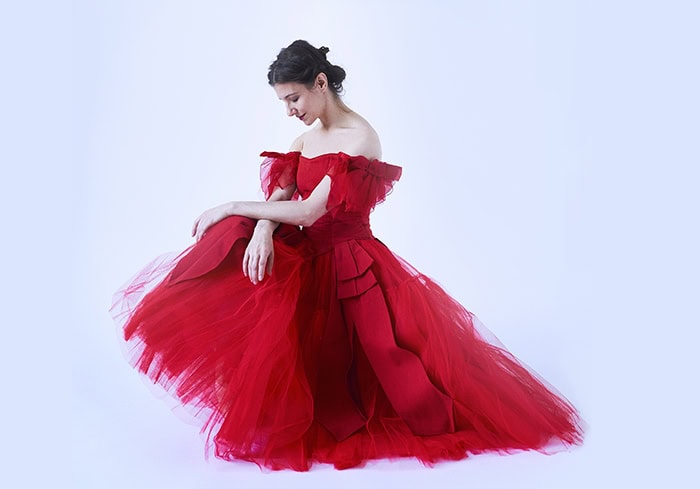Alina Cojocaru in Alina at Sadler’s Wells
Posted: February 29th, 2020 | Author: Nicholas Minns & Caterina Albano | Filed under: Performance | Tags: Alastair Marriott, Alexander Malter, Alina Cojocaru, Arvo Pärt, Charlie Siem, David McCormick, Denisenko Vladimir Andreevich, Dominic Harrison, Francesco Gabriele Frola, François Couperin, Johann Kobborg, Juliano Nuñes, Kim Brandstrup, Lagoda Alla Vecheslavovna, Luke Howard, Marcelino Sambé, Margarita Balanas, Obovskaya Larisa Nikolaevna, Rubina Alla Davidovna, Sasha Grynyuk, Sir Frederick Ashton, Takahiro Tamagawa, Tim Rushton | Comments Off on Alina Cojocaru in Alina at Sadler’s WellsAlina Cojocaru, Alina, at Sadler’s Wells, February 21

Alina Cojocaru, currently a principal dancer at English National Ballet, is the kind of performer who can efface her personality to fuse her creative self with the character she is playing. A program that celebrates her, such as the recent Sadler’s Wells evening, Alina, is thus faced with a challenge as to who is being presented. Cojocaru initially sidesteps the issue by stressing the musical heart of dance in a performance by cellist Margarita Balanas and violinist Charlie Siem of Handel’s Passacaglia for Violin and Cello.
We first see Cojocaru as performer in Tim Rushton’s Reminiscence, a duet for her and Johann Kobborg that Rushton began ten years ago and finished only recently. It is set to Arvo Pärt’s Spiegel im Spiegel — played live on stage by Balanas and pianist Sasha Grynyuk — the clarity of which is matched by the lightness of Rushton’s lines and gestures. Cojocaru inhabits these with ludic innocence, willingly accepting and returning the playful advances of an attentive and admiring Kobborg. As the first chapter in an expressive biography it reads as a coming-of-age ceremony in which the image of a butterfly opening its wings merges with the development of a mature relationship. Kobborg has a moment of casual virtuosity that he passes off with a smile, and they walk off together with a quiet sense of fulfilment.
There are two short films by Kim Brandstrup that act as introductions to the person from whom the performer develops, as well as serving the practical function of giving Cojocaru time to breathe and change between works. The first is Faces, to music by François Couperin, in which the camera focuses on Cojocaru’s face in front of a painted crimson backdrop; the proximity derives from Brandstrup’s pleasure in watching dancers ‘marking’ in the studio — ‘going through a choreography in their head while listening to the music’. Brandstrup abstracts from Cojocaru’s face the function of marking, leaving uncanny traces of an internal dialogue between person and performer.
Her next outing is in Juliano Nuñes’ Journey, a trio for herself, Nuñes, and Dominic Harrison to the music of Australian composer, Luke Howard. Nuñes’ choreographic profile has been rising over the last year; he is much in demand, and he evidently still enjoys dancing in his own creations. In an evening devoted to the art of Cojocaru, however, Nuñes manages to lose her by placing too much attention on her easy acquiescence and pliancy in being partnered.
Brandstrup’s second film, Kiev, is a homage to Cojocaru’s ballet teachers at the Kiev State Ballet School: Denisenko Vladimir Andreevich, Rubina Alla Davidovna, Obovskaya Larisa Nikolaevna and Lagoda Alla Vecheslavovna. She had not been there in 25 years and the video shot in the school by David McCormick captures this passage of time. Brandstrup treats the architectural space as a museum in which Cojocaru’s youthful flow of movement contrasts with the stark stillness and the gnarled hands of her teachers. The film evokes the power of communication through touch and the evident reverence of Cojocaru for her teachers and of her teachers for their student’s achievements. It is set, appropriately, to Arvo Pärt’s Für Alina, in a recording by Alexander Malter.
Kobborg’s Les Lutins, created in 2009 for Cojocaru, Steven McRae and Sergei Polunin, opens with displays of male virtuosity to an equally virtuosic Études-Caprices in A minor of Henryk Wieniawski played by Grynyuk and Siem. Marcelino Sambé sets the tone with a flamboyant but technically precise variation that flirts impishly with the musical accents in a delightful interplay with Siem. Takahiro Tamagawa enters with his own arsenal of male wizardry that escalates competitive bragging rights until Cojocaru steps into the fray in male attire and a mischievous smile. Her sassy brand of one-upmanship turns male bravado into competitive flirtation until she deflates both by her awed admiration for the violinist. As the two dancers kneel entreatingly at her feet, she pushes them over and offers her heart to Siem.
The second part of the evening is a performance of Frederick Ashton’s Marguerite and Armand with Francesco Gabriele Frola as Armand, Kobborg as his father, and Alastair Marriott as a quintessential duke. Kobborg is able to translate his close relationship with Cojocaru into a touching and utterly credible father-in-law to Marguerite, and while Frola’s impetuous passion fuels his duets with Cojocaru, his natural elegance is too well-mannered for Armand’s more brazen behaviour. Cojocaru remains in the eye of the buffeting storm, inhabiting Marguerite’s tragic story so unconditionally that in her disguise she fully reveals herself.
